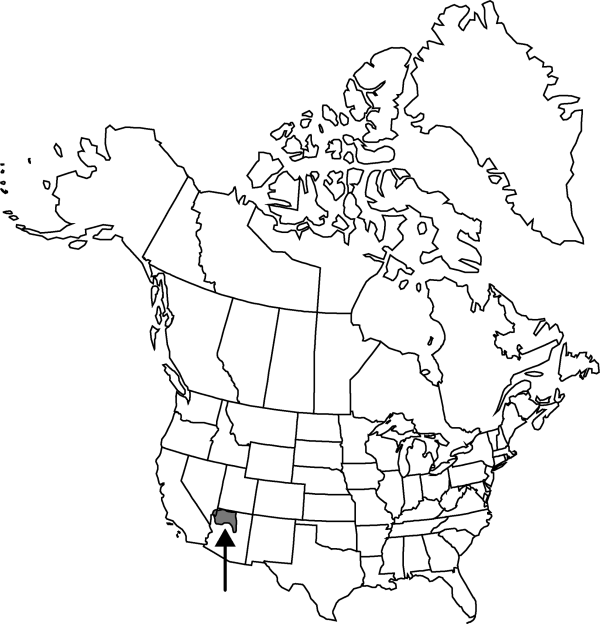familyCactaceae
subfamilyCactaceae subfam. Cactoideae
genusEchinocactus
speciesEchinocactus polycephalus
Difference between revisions of "Echinocactus polycephalus var. xeranthemoides"
Contr. U.S. Natl. Herb. 3: 358. 1896.
Endemic
Synonyms: Echinocactus polycephalus subsp. xeranthemoides (J. M. Coulter) N. P. Taylor
Treatment appears in FNA Volume 4. Treatment on page 190.
FNA>Volume Importer |
imported>Volume Importer |
||
| (7 intermediate revisions by 2 users not shown) | |||
| Line 6: | Line 6: | ||
|place=3: 358. 1896 | |place=3: 358. 1896 | ||
|year=1896 | |year=1896 | ||
| + | }} | ||
| + | |special_status={{Treatment/ID/Special_status | ||
| + | |code=E | ||
| + | |label=Endemic | ||
}} | }} | ||
|basionyms= | |basionyms= | ||
| Line 11: | Line 15: | ||
|name=Echinocactus polycephalus subsp. xeranthemoides | |name=Echinocactus polycephalus subsp. xeranthemoides | ||
|authority=(J. M. Coulter) N. P. Taylor | |authority=(J. M. Coulter) N. P. Taylor | ||
| + | |rank=subspecies | ||
}} | }} | ||
|hierarchy=Cactaceae;Cactaceae subfam. Cactoideae;Echinocactus;Echinocactus polycephalus;Echinocactus polycephalus var. xeranthemoides | |hierarchy=Cactaceae;Cactaceae subfam. Cactoideae;Echinocactus;Echinocactus polycephalus;Echinocactus polycephalus var. xeranthemoides | ||
| Line 19: | Line 24: | ||
}}<!-- | }}<!-- | ||
| − | --><span class="statement" id="st- | + | --><span class="statement" id="st-undefined" data-properties=""><b>Stems </b>gray-green to yellow-green. <b>Spines</b> red to straw colored, canescent, puberulent, or glabrous. <b>Fruit</b> scales tan, yellow, or reddish, aging yellow, 16–30 mm, usually longer than dried tepals at fruit apex. <b>Seeds</b> rounded (rarely faceted), 2.4–3.1 mm, smooth (exposed surfaces of testa cells flat or slightly convex, uniformly shiny). <b>2n</b> = 22.</span><!-- |
-->{{Treatment/Body | -->{{Treatment/Body | ||
| + | |phenology=Flowering Jun–Aug. | ||
|habitat=Rocky hills, slopes, and ledges of canyons, Great Basin and Mojave desert scrub, igneous and calcareous substrates | |habitat=Rocky hills, slopes, and ledges of canyons, Great Basin and Mojave desert scrub, igneous and calcareous substrates | ||
|elevation=500-1700 m | |elevation=500-1700 m | ||
| Line 33: | Line 39: | ||
-->{{#Taxon: | -->{{#Taxon: | ||
name=Echinocactus polycephalus var. xeranthemoides | name=Echinocactus polycephalus var. xeranthemoides | ||
| − | |||
|authority=J. M. Coulter | |authority=J. M. Coulter | ||
|rank=variety | |rank=variety | ||
| Line 40: | Line 45: | ||
|basionyms= | |basionyms= | ||
|family=Cactaceae | |family=Cactaceae | ||
| + | |phenology=Flowering Jun–Aug. | ||
|habitat=Rocky hills, slopes, and ledges of canyons, Great Basin and Mojave desert scrub, igneous and calcareous substrates | |habitat=Rocky hills, slopes, and ledges of canyons, Great Basin and Mojave desert scrub, igneous and calcareous substrates | ||
|elevation=500-1700 m | |elevation=500-1700 m | ||
| Line 46: | Line 52: | ||
|publication title=Contr. U.S. Natl. Herb. | |publication title=Contr. U.S. Natl. Herb. | ||
|publication year=1896 | |publication year=1896 | ||
| − | |special status= | + | |special status=Endemic |
| − | |source xml=https:// | + | |source xml=https://bitbucket.org/aafc-mbb/fna-data-curation/src/2e0870ddd59836b60bcf96646a41e87ea5a5943a/coarse_grained_fna_xml/V4/V4_357.xml |
|subfamily=Cactaceae subfam. Cactoideae | |subfamily=Cactaceae subfam. Cactoideae | ||
|genus=Echinocactus | |genus=Echinocactus | ||
|species=Echinocactus polycephalus | |species=Echinocactus polycephalus | ||
|variety=Echinocactus polycephalus var. xeranthemoides | |variety=Echinocactus polycephalus var. xeranthemoides | ||
| − | |||
| − | |||
| − | |||
| − | |||
| − | |||
| − | |||
| − | |||
| − | |||
| − | |||
| − | |||
| − | |||
| − | |||
}}<!-- | }}<!-- | ||
-->[[Category:Treatment]][[Category:Echinocactus polycephalus]] | -->[[Category:Treatment]][[Category:Echinocactus polycephalus]] | ||
Latest revision as of 21:58, 5 November 2020
Stems gray-green to yellow-green. Spines red to straw colored, canescent, puberulent, or glabrous. Fruit scales tan, yellow, or reddish, aging yellow, 16–30 mm, usually longer than dried tepals at fruit apex. Seeds rounded (rarely faceted), 2.4–3.1 mm, smooth (exposed surfaces of testa cells flat or slightly convex, uniformly shiny). 2n = 22.
Phenology: Flowering Jun–Aug.
Habitat: Rocky hills, slopes, and ledges of canyons, Great Basin and Mojave desert scrub, igneous and calcareous substrates
Elevation: 500-1700 m
Discussion
Selected References
None.
Lower Taxa
None.
... more about "Echinocactus polycephalus var. xeranthemoides"
